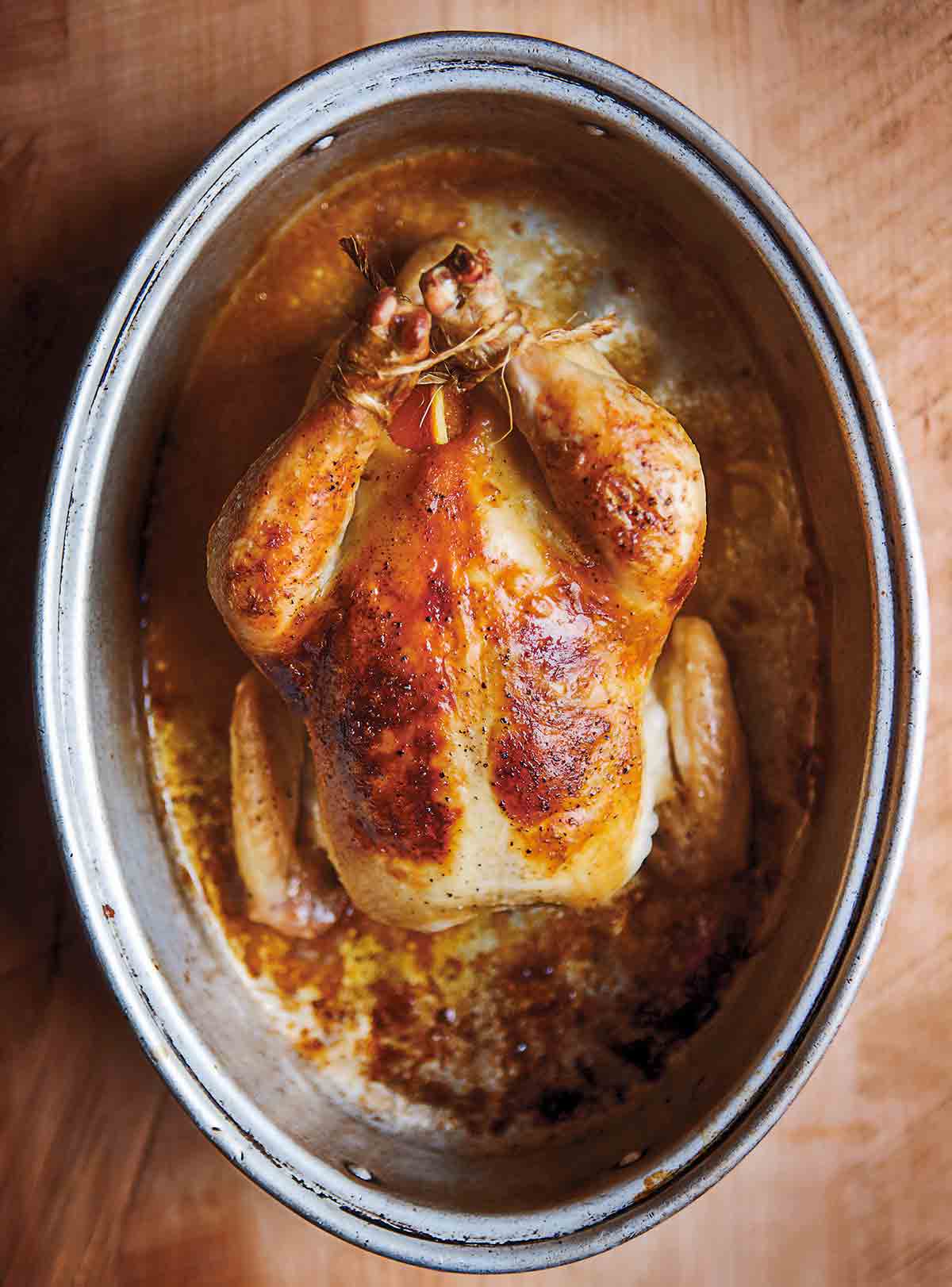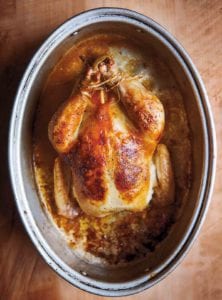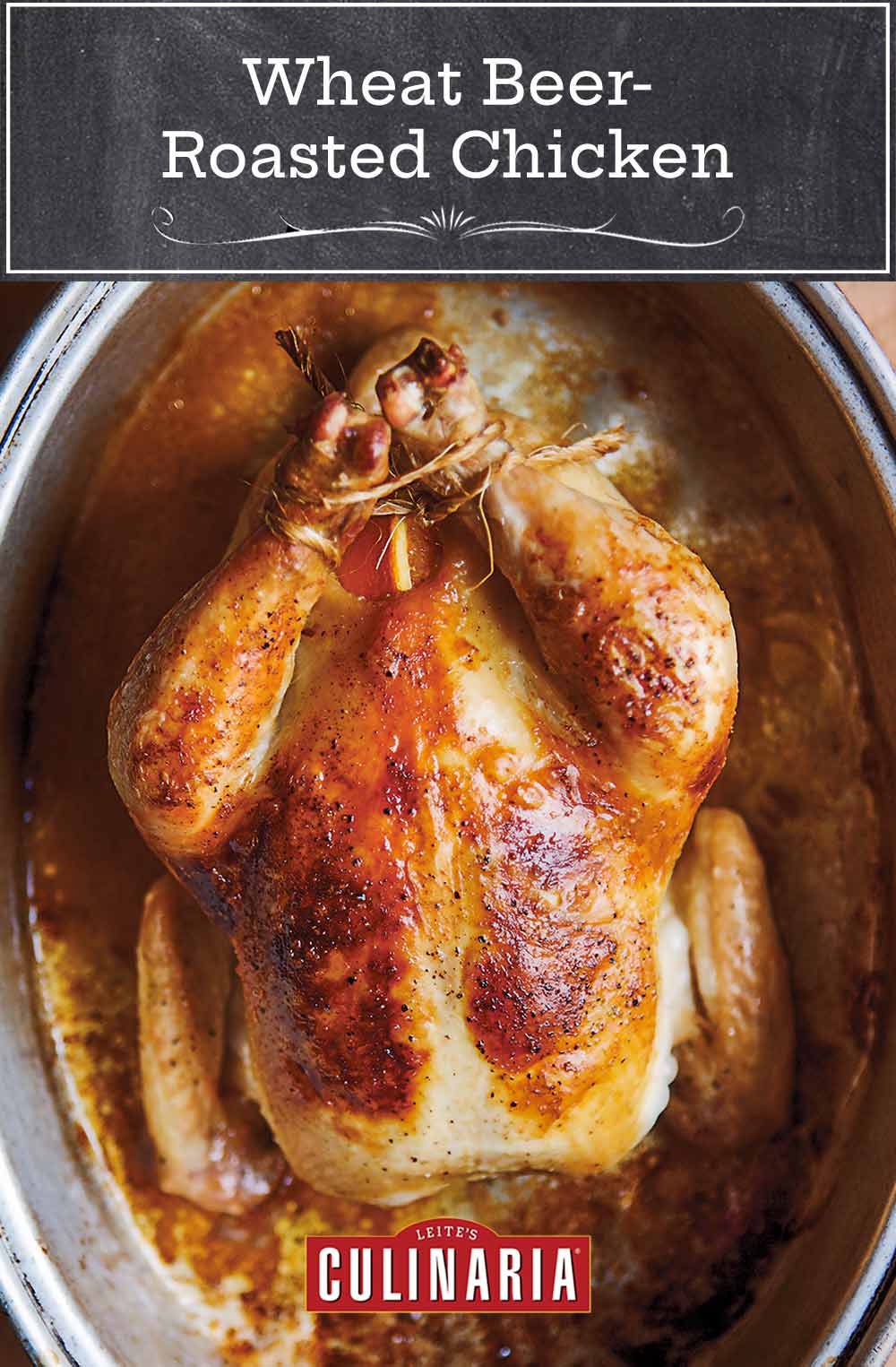
This roast chicken takes its flavors from one of the classic European beers: Belgian witbier. This style, which often uses orange peel and coriander seeds in the beer-making process, leads to unexpectedly wonderful flavors in the final brew—flavors that also happen to pair well with roast chicken.–Ian Knauer
What’s the best beer to use in this beer roasted chicken?
As noted above, this recipe was designed to use not just any old can of PBR but rather a European-style beer with subtle nuances. The brands we find to be fairly readily available include Blue Moon, Hefeweizen, and Shock Top. If those aren’t to be found in your local stores, you can opt for a lighter-style ale, such as a summer ale or even a slightly more robust Belgian farmhouse ale. You want something that has some complexity to it but isn’t overwhelmingly heavy or dark, as the beer is the foundation for the flavor of your pan sauce.

Wheat Beer Roasted Chicken
Equipment
- Kitchen string (optional)
Ingredients
- 2 tablespoons (1 oz) unsalted butter, at room temperature
- 1 teaspoon finely grated orange zest, preferably organic
- 1/2 teaspoon ground coriander
- 2 teaspoons kosher salt
- One (3 1/2-pound) whole chicken
- 1/2 teaspoon black pepper
- 1 large garlic clove, smashed and peeled
- 1/2 orange, preferably organic
- 1 cup wheat beer (witbier), such as Blue Moon, Hefeweizen, or Shock Top
- 1 teaspoon cornstarch
- 1 tablespoon water
Instructions
- Preheat the oven to 450°F (232°C). Adjust the oven rack to the middle position.
☞ TESTER TIP: If you've recently had a pie or anything else spill over and create a mess on your oven floor, you'll want to scrub that off prior to cranking the oven to this temperature. Or else be prepared to have some serious ventilation happening.
- In a small bowl using a fork or the back of a wooden spoon, work together the butter, orange zest, coriander, and 1/2 teaspoon salt until combined.
- Rinse the chicken and pat it dry. Gently run your fingers between the chicken skin and the meat, loosening the skin while being careful not to tear it. Push the butter under the skin, as far over the thighs and drumsticks as your fingertips or the handle of a wooden spoon will reach. Massage the chicken skin from the outside to spread the butter evenly over the chicken.
- Season the chicken inside and out with the remaining 1 1/2 teaspoons salt and the pepper. Place the garlic and orange, cut into chunks, in the cavity. If desired, loosely tie the legs together with kitchen string.
- Place the chicken in a flameproof roasting pan that’s not much larger than the chicken itself. (A large cast-iron skillet works quite nicely.) Roast the chicken, liberally basting it with some of the beer every 15 minutes, until the skin is golden and begins to pull away from the base of the drumsticks and the juice runs clear, about 50 minutes.
- Transfer the chicken to a cutting board and let it rest for 15 minutes before carving.
- Meanwhile, place the roasting pan over a burner and add the remaining beer. Bring the liquid to a simmer, scraping up any browned bits. Stir together the cornstarch and water in a small bowl, then stir the resulting corn starch slurry into the simmering pan juices. Simmer the gravy, stirring constantly, until slightly thickened, about 1 minute. If desired, strain the gravy.
☞ TESTER TIP: If you prefer a thinner consistency to your pan sauce as opposed to thicker, then you can omit the cornstarch and water slurry. It’s not essential. It’ll simply make your accompanying sauce more like a glossy gravy.
- Cut the strings from the legs, if using, and carve the chicken. Transfer the pieces to a platter and spoon the gravy over the chicken or pass it on the side.
Explore More with AI
Nutrition
Nutrition information is automatically calculated, so should only be used as an approximation.
Recipe Testers’ Reviews
This is a crazy-good roast chicken that, as an added bonus, is a cinch to make. We feasted on this crisp, juicy chicken. It was divine.
I used Sam Adams Summer Ale as my wheat beer of choice. To roast my chicken, I placed it in a 12-inch cast-iron skillet and poured the beer over it, straight from the bottle, while it was cooking. After exactly 50 minutes, I pulled the golden brown chicken from the oven (checking the internal temperature with a digital thermometer to make sure it was done, which it was), transferred it to a cutting board, and got to work on the gravy. Instead of adding the cornstarch slurry, I finished the sauce with a tablespoon of butter and some salt and pepper.
This makes a lovely roasted chicken, a posh version of beer-can chicken. I used Shock Top Belgian White. The flavor of the beer was subtle in the chicken and on the skin, but more pronounced in the pan sauce. The chicken was moist and flavorful. My diners were asking for more crisped skin. The cornstarch slurry stirred into the pan juices went nicely with the roasted potatoes I made. A very nice roasted chicken that I’d make again.
This recipe will definitely be in my circulation of awesome roasted chicken recipes, as I roast a chicken every few weeks. It was fun to try something new. And although I’m not certain I could detect the wheat beer flavor—the orange seemed to be more highlighted—the flavors were perfect together. The chicken was full of moist, citrus goodness.
To make the flavored butter, I got down and dirty, as I felt that combining the ingredients in my hands worked best (think of mixing meat loaf by hand). I’d recommend using a small roasting pan, one that’s close in size to the chicken. I used a larger pan and some of the drippings got rather dark. I don’t think the slurry was needed nor was the gravy needed at all, really. The chicken had an incredible juiciness all on its own!
This chicken recipe is a keeper. It cooked up nicely in the 50-minute time frame. It was moist and juicy with a crisp, seasoned skin that tasted fantastic. The beer “gravy” was easy to prepare and came together in a snap.
I needed to use 2 teaspoons of cornstarch to 1 1/2 tablespoons of cold water to get the gravy to a consistency that would pour well without spreading like broth all over the plate. The flavor of the gravy was outstanding and tasted wonderful on our potatoes too. I used a hefeweizen, which worked very well. This is an easy way to roast a chicken with a unique twist on the gravy.
I used a Belgian farmhouse ale for this recipe. This is a beer that often incorporates wheat and spices such as orange zest, coriander, and ginger, so I felt it would pair quite well with the chicken. And it surely did! The compound butter under the chicken skin and the garlic and orange in the cavity imparted a wonderful, rich orange flavor to the chicken and the gravy as well. The little bit of slurry added to the roasting liquids gave it just the right amount of substance to coat the meat on the serving platter. I’ll definitely be making this recipe again and again.
The wheat beer reduction gives this moist roasted chicken an unexpected savory quality. A cast-iron skillet was the perfect “flameproof” roasting pan for this recipe. I opted not to add the cornstarch and just reduced the sauce to my preference.
The directions for this chicken were very straightforward. The finished product was a crisp-skinned, mahogany-colored, moist, delicious chicken. I liked the fact that specific beers were recommended for folks who may not know beers well enough to pick an appropriate one. We used one of the suggested beers, Blue Moon. Initially I was a tad concerned with the 450°F oven. With that high a temperature, we’ve set off the smoke detector when roasting chickens many times in the past. Perhaps it was the combination of the beer and a fairly lean, organic, air-dried chicken, but we had no problem with smoke at all, and no need to pull a chair over to where the smoke detector is.
One thing that bothers me with many roasted chicken recipes is that they rarely tell you how to put the chicken in the pan. Personally, we like to first put the chicken in breast-side down, and then we turn it breast-side up, usually halfway through the cooking process, which is what we did in this case. However, there are a lot of folks out there who may not know “which end is up,” so to speak, and would like to know which end should be where.
There was no need to add the cornstarch slurry. The pan juices resulting from adding the rest of the beer to the browned bits in the pan were wonderfully flavorful and a beautiful color that made our plates very enticing. It was a feast for the eyes, as well as one for the stomach.
Really good recipe. The chicken meat was moist and tender and tasty, including the breast. The skin was crisp and delicious. And the directions were easy to read and understand and quite accurate.
Roasting chicken at 450°F is my preferred method, since it creates a great crisp skin and moist meat. I loved the Blue Moon beer baste, and it left some great fond (the stuff left on the bottom of the pan), which made a terrific sauce. I added the juice from the 1/2 orange leftover from what goes in the cavity to the beer that I basted with and it was really tasty. I didn’t need the cornstarch and water; the sauce was just fine without it. If you had a lot of beer left and added it afterward to the pan when the chicken was done, perhaps you’d need the slurry to thicken things, but I didn’t find it necessary.
Will definitely make this again. Oh! And if you bought more than 1 bottle of beer and have any left, the beer itself is delicious nice and cold with a slice of orange in it.
This recipe produces a wonderfully moist and flavorful chicken. The pan gravy is also quite tasty. The only downside is that this also produces a fair amount of smoke from the hot oven, even with the basting. Plan ahead for good ventilation when making this.
The basting used up most of the cup of beer—I used a hefeweizen—so I added a little more to make the gravy. This recipe is definitely a keeper. I don’t know if the slurry is absolutely necessary, but I liked the way it came out, so I wouldn’t change it. I grew up eating gravy thickened with cornstarch this way, and it just seems right to me.
I found this to be a fun recipe. My chicken was about 4 1/2 pounds. Because of the size difference, I had to cook it for an extra 20 minutes. I used Blue Moon and it gave off a great flavor, although I think any wheat beer or even Leinenkugel Honey Weiss would be great.
I basted the chicken with a 1/4 cup of beer every 15 to 20 minutes. There wasn’t any beer left, but the gravy was okay without it. Depending on how thick you like your sauce, I’d suggest doubling the cornstarch.
















Hi, I am not a fan of whole chickens. Could I use split breasts, leaving the skin on, instead? I would just have to check when it is done myself. Thanks.
Yes, you can Camille. Check for doneness earlier than the recipe indicates as it will likely be finished faster than cooking a whole chicken.